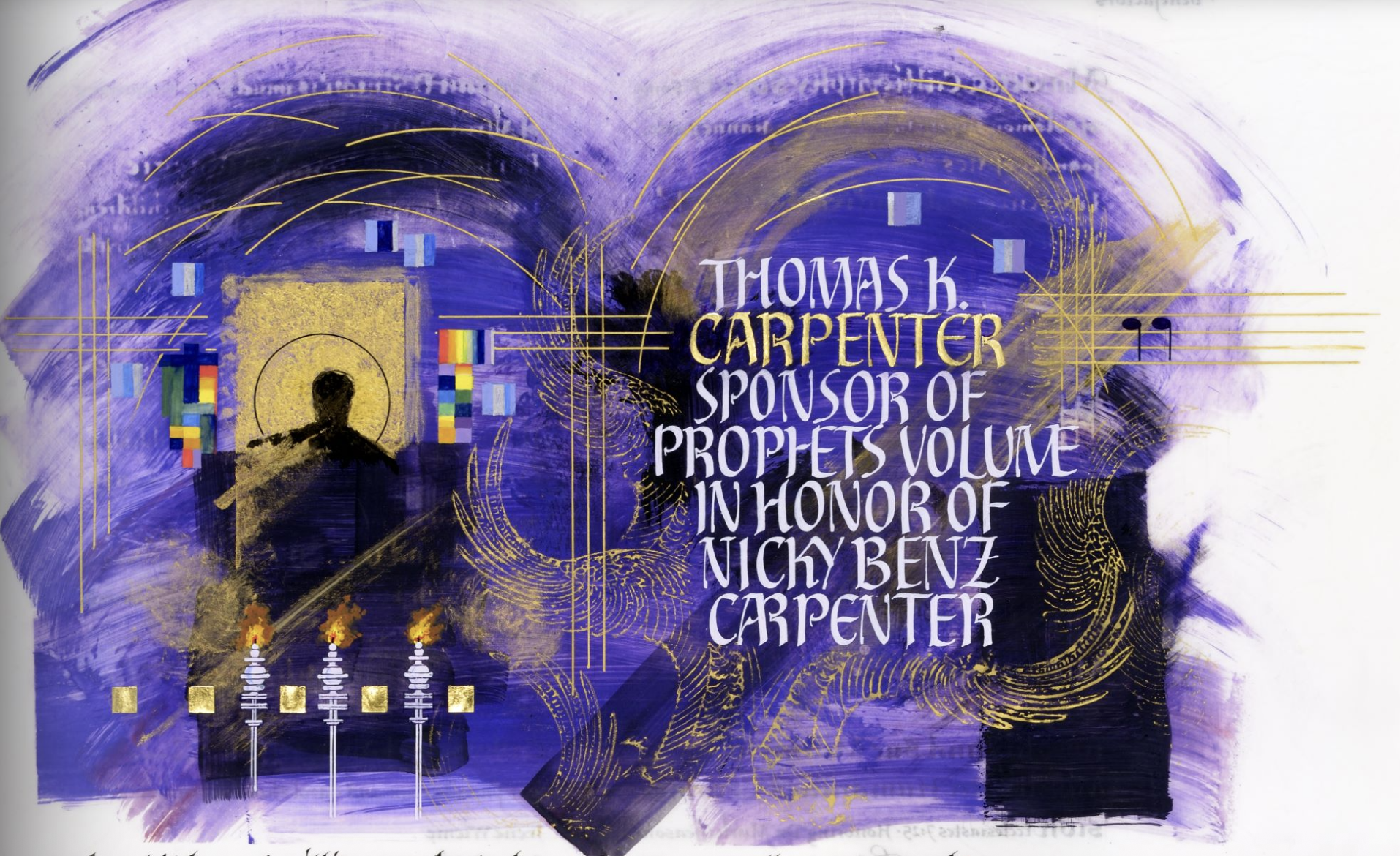The Women of The Saint John’s Bible: Diane von Arx on the Bible’s Eighth Volume
Minneapolis, MN– Common knowledge understands that The Saint John’s Bible consists of seven volumes. Well, this is only partially true.
 While the original manuscript and all of the Bible’s fine art editions, such as the Heritage and Apostles Editions, do consist of seven volumes, there is actually an eighth and final “volume” of The Saint John’s Bible, a companion work titled The Book of Honor.
While the original manuscript and all of the Bible’s fine art editions, such as the Heritage and Apostles Editions, do consist of seven volumes, there is actually an eighth and final “volume” of The Saint John’s Bible, a companion work titled The Book of Honor.
This book recognizes and celebrates the vision, creativity, and generosity of those who created and funded The Saint John’s Bible. This “eighth volume” of The Saint John’s Bible includes the names of those who planned, designed, directed, and crafted the Bible, including theologians, artists, scholars, scribes, and administrators, as well as more than 1,400 benefactors whose gifts supported the project.
The artist behind the Book of Honor is none other than Diane von Arx, a Minnesotan lettering artist whose work spans from corporate graphics to fine art and everything in between. Through her career, she has designed product package lettering for General Mills and other clients, taught calligraphy workshops across the globe, and honed an impressive portfolio of graphic lettering and fine art prints.
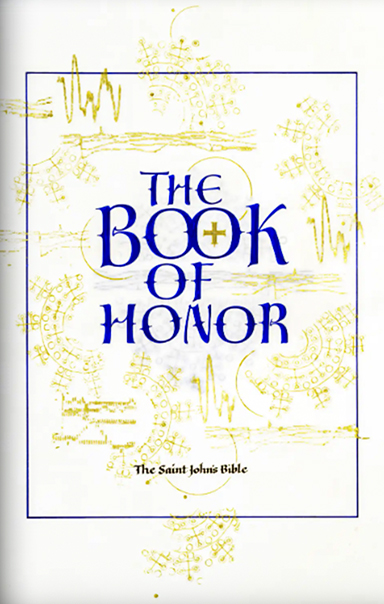
“It’s only fitting that the world’s most beautiful and famous contemporary handwritten Bible would have a worthy companion,” said Rob Culligan, Vice President of Institutional Advancement at Saint John’s University. “The Book of Honor is arguably the planet’s most stunning and breathtaking handwritten and illuminated donor recognition tome. It was made possible by the remarkable artistic creativity of Diane von Arx. She knocked it out of the park. Simply put, it’s an extraordinary magnum opus.”
In 2004, Artistic Director, Scribe, and Illuminator of The Saint John’s Bible Donald Jackson brought on von Arx as the final artist to join The Saint John’s Bible project. According to von Arx, Jackson had been implying that he wanted von Arx to be a part of The Saint John’s Bible project for years. After all, the two were long-time colleagues and friends, first meeting in 1977 at a calligraphy workshop in Minneapolis, Minnesota. Still, she never told anyone until it was official.
When all was said and done, von Arx had completed four original special treatments in the Wisdom Books volume of The Saint John’s Bible. It wasn’t until later that von Arx realized that one of the reasons Jackson wanted her to work on the Bible was to lay the groundwork for her to become the artistic director of The Book of Honor.
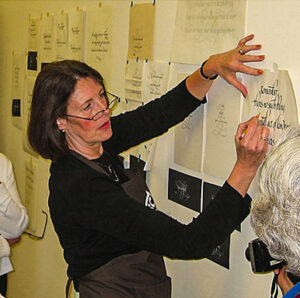
“I believe that one of the reasons that Donald had me work on the Bible was because he intended to ask me to create The Book of Honor,” said von Arx. “My background is in graphic design, so I understand type setting and how to present an outline or draft such that the committee at Saint John’s could understand the plan and vision for the project before proceeding with a design.”
Discussions about The Book of Honor began in 2005, while the creation of the original manuscript was still underway. The conversation began between Founding Director of The Saint John’s Bible Carol Marrin and von Arx. Then in 2009, the conversation reignited with Marrin’s successor, Tim Ternes. In 2010, Deputy to the President for Advancement, Fr. Eric Hollas, and Rob Culligan, were brought into the fold, and formal conversations about expectations for the work propelled work to finally begin.
The Work Begins
The early days of brainstorming for The Book of Honor began in unlikely places, such as presentations and exhibitions of The Saint John’s Bible around the United States.
Finally, the project’s key players–Culligan, Ternes, and Hollas–sat at von Arx’s dining room table at her home studio in South Minneapolis. By this time, von Arx had already had thorough discussions with a few other artists, on the project: Thomas Ingmire and Suzanne Moore, and with Donald Jackson. From their guidance and her own instincts, she entered the room knowing exactly what needed to be done.
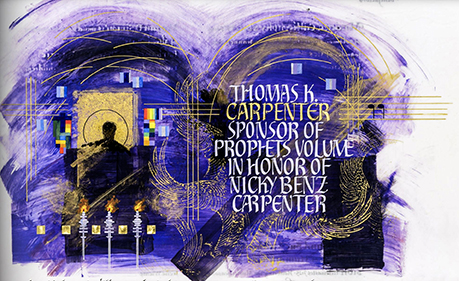
In this case, that key ingredient would be the very material of the original manuscript–vellum.
“A lot of calligraphers are just not comfortable with doing a large original document, because we all make mistakes,” said von Arx. “The difference between an amateur and a professional is that a professional knows how to correct their errors. On vellum, I can correct my errors. On cotton, I cannot.”
Ingmire and Moore had agreed with von Arx that vellum was the best option. Sarah Harris, Jackson’s studio manager, had generously agreed to prepare all of the vellum and rule lines on each skin, which would be provided by Cowleys in England, for von Arx.
“God bless her [Sarah],” said von Arx. “She’s my saint. Another huge support on the project was Suzanne Filbin, a friend and fellow colleague, who agreed to typefit the entire volume, similar to what Vin Godier did for Donald in the Bible.”
It was during this time that other material and layout considerations were decided upon as well. The page size, two-column width, folios and gatherings would follow the lead of those in the Bible. Just as it was with the original manuscript, von Arx used goose and turkey quills with fine stick ink for the text. For the illuminations, she used gouache, powdered pigments, casein paints, gold leaf and powdered gold.
As artistic director, von Arx was also charged with designing a script for The Book of Honor. As was the vision for the rest of the Book, von Arx’s script was to be very close to the Jacksonian script designed by Jackson for The Saint John’s Bible, but must still come distinctly from the hand of von Arx.
“My calligraphic work is typically legible. It might come from my graphic design background,” said von Arx. “I have people who come up to me and say, ‘That’s yours, isn’t it?’ My style is mostly a lively italic or Roman, and it’s always legible.”
“Diane’s background as a commercial graphic artist and designer served her well,” said Tim Ternes, Curator of The Saint John’s Bible. “She was given a pile of words–a standard donor list of hundreds of dedications and names. There was no standardization or structure, and Diane made something truly beautiful out of it. The result is a donor recognition that people actually read, spend time perusing, and enjoy coming back to time and time again.”
Taking Inspiration from the Original
For an artist to create work that honors a donor whom they’ve never met is not an easy task. However, von Arx came up with the perfect way to go about it.
“I would look at the frontispiece or an illumnation from the volume that the donor sponsored, and I would draw from its design and artwork to create something meaningful and relevant,” said von Arx. “I often emulated what Donald or the other artists had done in the design.”
However, when von Arx did happen to receive special intel into a donor or the nature of their gift, she found a way to incorporate it. Take, for example, the design for the Baustert family, a donor family that all but saved the project halfway through its production. For the design, von Arx wanted to pay tribute to the idea of something in progress.
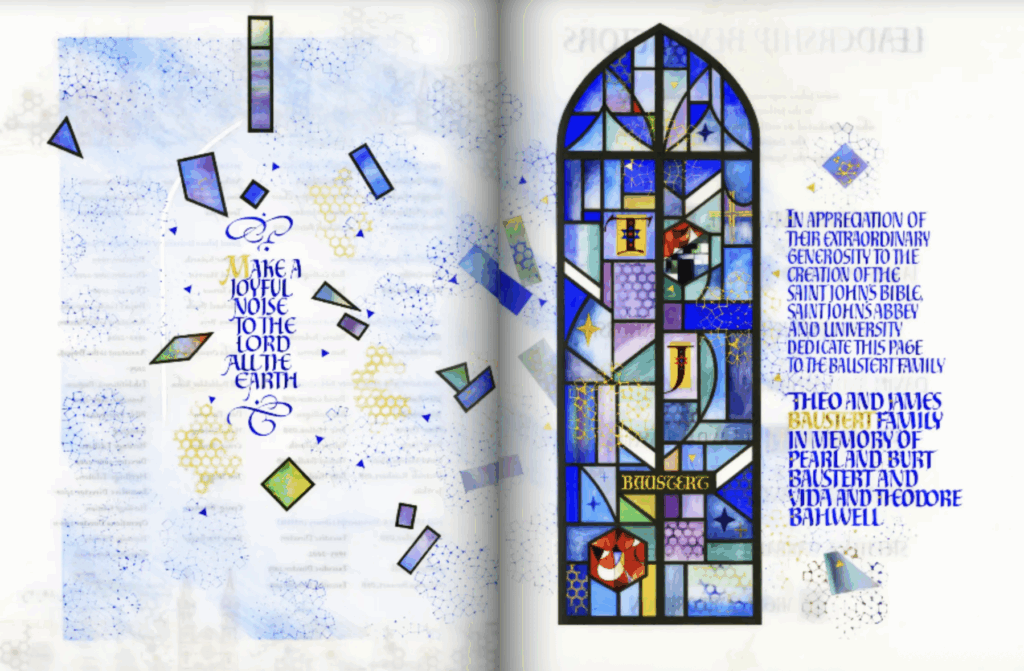
In the end, she represented this idea through a stained glass window. A representation of individual pieces of glass coming together to create something beautiful, and a vision of what is ahead through the beautiful color of the present, was the perfect motif to honor this family that had ensured that The Saint John’s Bible could still proceed past the halfway point. She also included a ‘T’ and a ‘J’ in the work to represent the donors’ initials (used in the chapter caps and designed by Donald) in the Bible. You may also see stained glass window panels from the Chapel on SJU campus, incorporated into the Baustert Window.
All planning and precision accounted for, most of the magic of von Arx’s work is in its spontaneity. Equipped in her mind with the imagery she’d like to reference, she lets her tool decide how it will flesh out on vellum.
“My hand and my tool dictate my work,” said von Arx. “I don’t sit in front of an empty page. I start pushing the tool because the tool is helping me design what I call a fine art piece.”
After more than five years of disciplined work, The Book of Honor was completed in May 2015. Still, there are several blank pages in The Book of Honor to celebrate future donors as they come.
“The Book of Honor is the pièce de résistance of what I’ve been able to do,” said von Arx. “This was the work of my lifetime. It’s my legacy.”
“Diane’s creation of The Book of Honor is an artistic achievement of our time unlike any other,” said Executive Director of The Saint John’s Bible Heritage Program, Rev. Dr. John F. Ross. “Her creative gifts are matched only by her delightful personality and sense of humor. I look for every chance to collaborate with Diane because I know the artistry will be breathtaking…and the process along the way will be lots of fun! She’s a gift to this ministry and to the world.”
The Saint John’s Bible: Leaving a Legacy
To learn more about Diane von Arx and view her work, visit her website here.
To read more stories similar to this one, visit the blog on saintjohnsibible.org and subscribe to the monthly e-newsletter, Sharing the Word.


